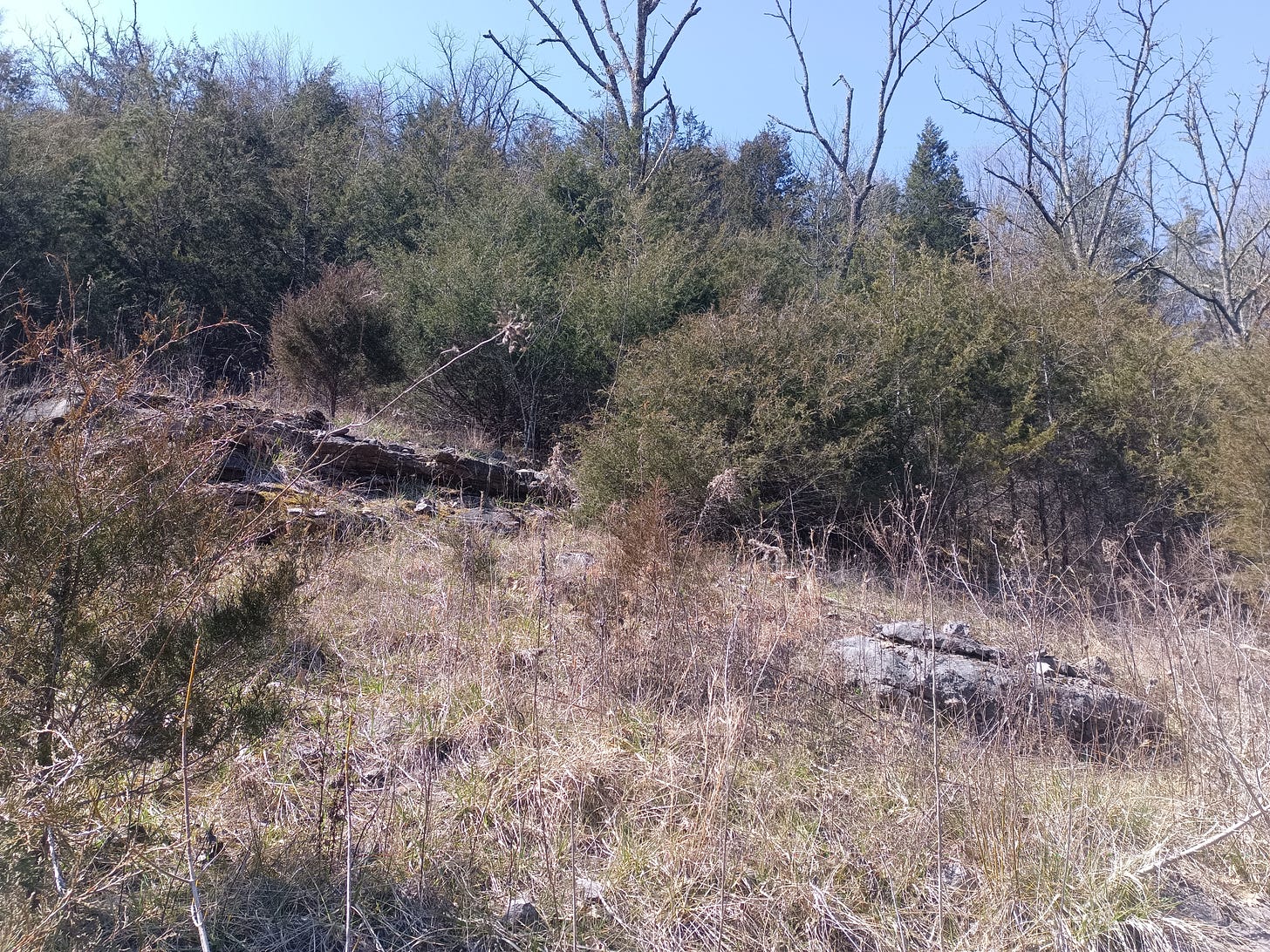Hey! It’s been a while since my last post. I mentioned last year that my wife and I were about to move to what is hopefully our permanent home. Well, we did, and that’s one of the reasons I’ve gone quiet here. We’ve been planning and starting a garden, taking inventory of the woods and old log skid trails, fixing up stuff around the house, and so on.
I’m a forester by trade, so I couldn’t help but make mental lists of the many ecological sore spots in the degraded hardwoods that make up our homestead: pressure from exotic invasive species, erosion concerns and skid road failures, unwanted mesophication,1 and on the list goes.

While we’ve been planning plots in the garden, we’ve also been plotting plantings around the house like native flowers and vines, clover, fruit-bearing trees. I’ve been thinking of everything in the woods I want to cut down and what to replace it with: whatever comes up naturally in some cases, in others maybe pecans, pawpaws, and shortleaf pines. It’s gotten us excited and poring over seed and nursery catalogues and saving up for tools like chainsaws and drip torches.
Thinking about the kind of diversity I want to develop at home has me thinking about another kind of diversity—one probably more relevant in the news cycle and to the zeitgeist of the first world. Does ecological diversity teach us anything about human diversity? About those ideals of “diversity, equity, and inclusion” in our places of work, worship, and recreation? My hunch is that the study and application of ecology should teach us about diversity, and if we neglect to learn it, our attempt to value and promote “diversity” in the civilized world will continue to be a colossal failure.
To start with, our society tends to assume “diversity” is intrinsically good. Preposterous—to even make such a claim we would have to know what diversity is and we seem incapable of producing a healthy definition without getting bogged down in skin colors, genders, and whether someone is gay or straight or any other number of self-identities all ironically irrelevant to what it means to be a self.
Let’s restrict ourselves to ecology here, and you can decide if there’s an analogy to be found. Diversity is important to keep an ecosystem functioning and healthy: pick your favorite examples of symbiosis, mutualism, parasitism, etc. When one species goes extinct or is extirpated, that area tends to lose valuable complexity and can even lead to butterfly effects as other species that relied on previous interactions in the ecological web dwindle or suffer. But on the other hand, diversity can be artificially inflated to absurd levels with no positive benefit by introducing all sorts of species, even manually keeping them alive whether they would naturally survive or not.
What you end up with is not a self-interactive and self-corrective system, but a tangled mess with reduced value to neighboring ecoregions and probably requiring human effort and resources to maintain. Just look at a fancy garden, especially one with a hired gardener. Worse, our gardens often cause real harm to neighboring areas. Just look at a wooded area near a suburb: instead of a majestic overstory, you might find dozens of junky trees choked by exotic vines like English ivy.2 And instead of a healthy understory with stems to one day replace that overstory, you’ll find carpets of shrubbery and even grasses from nearby lawns, gardens, and fencerows: privet, fortune’s spindle, bush honeysuckle, and so on.
Hellscapes, to my eyes. All because of our love for “diversity” and a taste for beauty restricted to archaic, classist, European norms.
“One of the penalties of an ecological education is that one lives alone in a world of wounds. Much of the damage inflicted on land is quite invisible to laymen. An ecologist must either harden his shell and make believe that the consequences of science are none of his business, or he must be the doctor who sees the marks of death.”
— Aldo Leopold, Sand County Almanac
Maybe you can relate, maybe not. Either way, it’s obvious that function, health, and mutually beneficial interaction are important in whether a particular manifestation of diversity is good or beautiful. I mean, we all understand this if we’re willing to be honest with ourselves. Colonialism is a form of diversity, after all—bringing a new culture, ethnicity, and understanding of community to some place different.
Beautiful, good human diversity is imbibed and expressed through relationships—mutually beneficial interactions. Often, it will coincide with superficial diversity like multi-ethnic workplaces, inclusive and welcoming communities, or varied local traditions. None of these things are intrinsically bad, by the way, but they are not real cultural diversity! Nowhere is this more apparent than in the gradual extermination of rural culture in the US by the ever sprawling city. People with all sorts of skin colors, native languages, religious beliefs, and birthplaces are moving from the city to the country, but they all bring the same money, the same economic values, the same concrete and asphalt, the same citified understanding of choice in commodities and preferences. The very thing they come to participate in is devoured and replaced with the same restaurant chains, the same warehouses supplied by the same slave labor, the same broken materialistic culture.
Don’t hear me as saying that people moving to the country are bad or country people are better. That would be a self-condemnation. My point is that if diversity is defined by demographics alone, it is superficial. Only relationships, and all the learning and discomforts that accompany them, foster functional cultural diversity.
This comparison to ecology is only an analogy, and analogies all break down at some level of scrutiny. But I think it provides a useful starting point. Why do we value diversity? What function does it provide, how real or robust is it, and by what standards do we assess its beauty?
A garden with hundreds of varieties of out-of-place species isn’t diversity. It’s a breeding ground for ecological threats and a resource sink justified only by a vague and exclusively acquisitional standard of beauty.
A manicured forest with perfect rows of massive majestic trees isn’t diversity. It’s a plantation.
A business in which people of every skin color and gender work, but all of them live the same monotonous existence of dropping kids off at daycare before going to 9-5s, evenings of television and DoorDash, and weekend outings reduced to watching sports and drinking with more carbon copies of themselves isn’t diversity (or freedom). It’s a group of people willingly conformed to the cultural monolith no matter their varied heritages.
A mall food court with fast food American, Chinese, Mexican, and a half-dozen other half-baked cuisines isn’t diversity. It’s a cultural graveyard in which culture is a commodity to be painlessly acquired, consumed, and spit out.
“Technique, which transforms culture into luxury, puts so many cultural modalities at the reader’s disposal that none of them has any more importance than any other; the customer becomes a butterfly dipping into whatever flower he chooses.” — Jacques Ellul, The Technological Society
So what, you ask? Food courts are fun places to hang out with friends. Fast food is delicious. Colorful flowers are pretty. Ethnic diversity is beautiful. I won’t disagree. But understanding non-superficial diversity with value to people, the earth, and any meaningful standard of beauty is relevant to our lives because we cannot hope to find solutions to the world’s problems with our modern, industrial, culturally monotone approach. We’ve let one specific and warped standard of diversity onto our incredibly small and naive societal toolbelt. Where diversity is lacking, force it down people’s throats; where one culture dominates, replace it with another; where ignorance is common, multiply it; where the industrial economy has created regions of poverty, use that selfsame economy and methods to alleviate it, no matter what part of the world we kick that can toward.
Wendell Berry makes this point better than I could:
A typical example of the conduct of industrial heroism is to be found in the present rush of experts to “solve the problem of world hunger”—which is rarely defined except as a “world problem” known, in industrial heroic jargon, as “the world food problematique.” As is characteristic of industrial heroism, the professed intention is entirely salutary: nobody should starve. The trouble is that “world hunger” is not a problem that can be solved by a “world solution.” Except in a very limited sense, it is not an industrial problem, and industrial attempts to solve it—such as the “Green Revolution” and “Food for Peace”—have often had grotesque and destructive results. “The problem of world hunger” cannot be solved until it is understood and dealt with by local people as a multitude of local problems of ecology, agriculture, and culture.
The most necessary thing in agriculture, for instance, is not to invent new technologies or methods, not to achieve “breaththroughs,” but to determine what tools and methods are appropriate to specific people, places, and needs, and to apply them correctly… no two farms or farmers are alike; no two fields are alike.
— The Gift of Good Land
I don’t think politicians or non-profits or businesses or any other human collective is gonna figure out what diversity is or how to promulgate it in their desperate work of progress. But while they work it out, promote diversity your own way. It’ll probably be more effective.
As for me, I’ll take my chainsaw and gun to the woods and kill stuff.
By mesophication, I’m referring generally to the way that more shade-tolerant tree species tend to outcompete other species present in the overstory due to a lack of small-scale disturbance, wildfire, or prescribed fire. Basically, there are fewer oaks, pines, and poplars than I would like and more red maples, trees-of-heaven, and other trees that don’t suit my objectives (which include a functional diversity of both species and habitat types) as well.
I suppose this should go without saying but everything is native somewhere and every species responds differently to different sites. I’m speaking from the perspective of a practitioner in Tennessee, and the principle applies worldwide though the specific examples will vary.






I read through this pondering the intentions and implications. Overlaying it onto my experiences thus far, I cannot shake off or untangle the feeling that vanity is a huge part of why humans act so disgusting. Which is a great irony.
I think this viewpoint is spot on. Enjoyed this article.